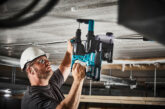
Jason Covell, Senior Product Manager at Deta, discusses the need for face masks or coverings that fit the needs of the individual wearer.
Procuring suitable, compliant and fit for purpose face masks has become hugely relevant and critical as the current COVID-19 pandemic has evolved worldwide.
In recent times, never has demand been greater for urgent supply of face masks to those that most need them; this includes key workers who continue to maintain essential services in the construction and manufacturing industries and/or those needing to protect themselves in situations where guidelines on social distancing are difficult to achieve.
One of the most common forms of protection against this respiratory virus is a face mask or covering. It is important however that any face mask or covering protects the wearer appropriately and avoids a false sense of unbreakable protection against the COVID-19 virus. Recognising the different types of face masks available as well as the varying specification, performance and recommended application for these is of particular importance.
Protective masks (to EN 149:2001+A1:2009)
A protective mask, otherwise known as a respirator or filtering face piece (FFP), is designed to protect the wearer from exposure to airborne contaminants and is classified as personal protective equipment (PPE). Protective masks are designed for either single use in which case they are marked “NR” (non-reusable) or for multiple use in which case they are marked “R” (reusable).
FFP2/FFP3 masks are PPE category III according to the Regulation (EU) 2016/425. This means that the conformity assessment includes a type examination by a notified body, resulting in an ‘EU type-examination certificate’ as well as production follow-up by a notified body. This enables the mask to be CE marked with the number of the notified body responsible for the production follow-up printed next to the CE marking.
With the outbreak of Covid-19, the EU has implemented Regulation (EU) 2020/403 which states that as long as masks have met the essential health and safety requirements of Regulation (EU) 2016/425 and have been assessed in line with the regulatory easements in (EU) 2020/403, they can be placed on the market without completing a formal conformity assessment procedure by a Notified Body and without the need to be CE marked.
Accordingly, in order to demonstrate compliance, a manufacturer must have submitted a formal application to a Notified Body and have been accepted into their process of conformity assessment, and the Notified Body must have confirmed that the product has an adequate level of health and safety in accordance with the essential requirements laid down for that product. Guidance from the Office for Product Safety & Standards (OPSS) confirms this in respect of masks for use outside of the healthcare sector, i.e. by the general public.
It should be noted that this is an evolving situation and that Government guidance may be subject to revision.
Medical masks (to EN 14683:2019+AC:2019)
A medical face mask, also known as surgical mask, is a medical device covering the mouth, nose and chin ensuring a barrier that limits the transition of an infective agent. They are used to reduce and/or control the spread of large respiratory droplets from the person wearing the face mask.
Medical masks comply with requirements as defined in European Standard EN 14683:2019 and should be CE marked.
There are two main types:
o Type I – for use by patients and other persons to reduce the risk of spread of infections. Not intended for use by healthcare professionals in an operating room or other medical settings.
o Type II and Type IIR – primarily for use by healthcare professionals in an operating room or other medical settings. Type IIR signifies the mask’s splash resistance.
Community masks
A community mask, otherwise known as an everyday/DIY mask is neither a PPE mask or a medical mask for which there are no European standards or testing requirements. These masks can under no circumstances replace respiratory protective equipment in the workplace, nor can they replace medical masks in healthcare settings or be used by healthcare professionals. Community masks include various forms of self-made or commercial masks or face covers made of cloth, other textiles or other materials such as paper.
Appropriate use of face masks is important
Protective masks and Medical masks should completely cover the face from the bridge of the nose down to the chin. Hands should be cleaned with soap and water or alcohol-based hand sanitiser before putting on and after taking off the mask. When taking off the mask, remove it from behind and avoid touching the front side. If the mask is disposable, dispose of the mask safely and wash your hands or apply alcohol-based hand sanitiser immediately after removing the mask.
Whilst the current all-time high demand for masks during these unprecedented times continues to place significant pressure on supply chains, the importance of procuring suitable, compliant and fit for purpose masks must not be compromised.
Get more information about Deta Electrical by clicking here








